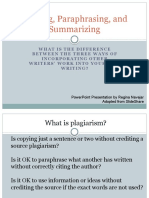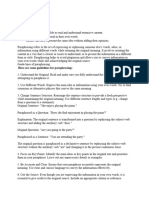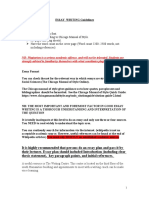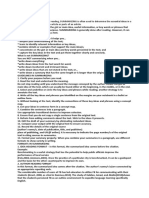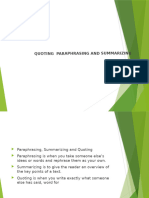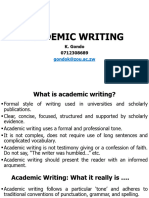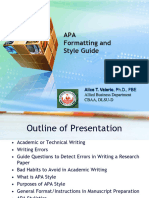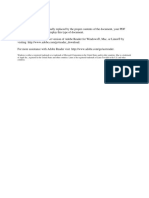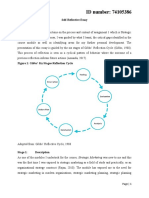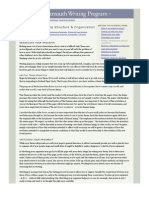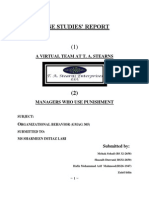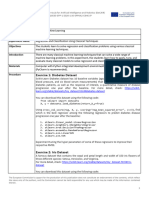Paraphrasing: What Does Paraphrasing Involve?
Paraphrasing: What Does Paraphrasing Involve?
Uploaded by
Micheal OlotuCopyright:
Available Formats
Paraphrasing: What Does Paraphrasing Involve?
Paraphrasing: What Does Paraphrasing Involve?
Uploaded by
Micheal OlotuOriginal Title
Copyright
Available Formats
Share this document
Did you find this document useful?
Is this content inappropriate?
Copyright:
Available Formats
Paraphrasing: What Does Paraphrasing Involve?
Paraphrasing: What Does Paraphrasing Involve?
Uploaded by
Micheal OlotuCopyright:
Available Formats
Paraphrasing
Two ways that students use to evidence reading in their work are quoting and paraphrasing.
Definitions
Quoting means accurately repeating, inside speech marks, what is written or said
word for word.
Paraphrasing means rewriting information using your own words
What does paraphrasing involve?
Paraphrasing is demonstrating your understanding of the texts you are reading by writing
them in your own words. To do this you need to write an accurate account of the text you
have read and include references in the appropriate style to show exactly where the
information has come from. If you do not reference, you are not acknowledging the work
that has been done by someone else and this is called plagiarising. Your tutor will point this
out to you and it is a form of ‘academic dishonesty’.
Sometimes paraphrasing is also referred to as summarising although this is slightly different
in that you need to write more precisely and convey the meaning in as few words as
possible.
Why paraphrase?
Paraphrasing is better than quoting, because a quote in your writing only shows your ability
to copy from a text but does not demonstrate any understanding of your reading unless you
then include an interpretation of the quote. However, this is then a waste of words.
Paraphrasing is a way of showing your understanding of the information you have read but it
is a descriptive way of writing. It is a good starting point for developing your academic
writing style and learning to understand the need to reference in your first year at university
but as you move into later years you will need to develop a more critical approach. To
develop your writing further you need to read the critical thinking factsheet.
Paraphrasing (or summarising) allows you to:
• Show your understanding of the original source.
• Discuss links and connections between the cited work and the point that you are making.
• Ensure the reader can grasp broad ideas or arguments without reading the source text.
It provides a context for the topic.
• Compare and contrast sources, making you more able to demonstrate that you have
adopted a critical approach to your reading.
To develop your ability to paraphrase:
• Keep the paraphrase as simple as possible.
• Express the points concisely.
• Use your own words and do not be tempted to copy from the original text unless there is
to include technical language.
Academic Skills Updated August 2020 Page 1 of 2
What not to do when paraphrasing:
• Use the same sentence structure as the original source: for example, only changing a
few words.
• Only slightly adapt the original source and then pass this off as your own summary or
paraphrase.
• Copy useful pieces of the original text and pad it out using your own words.
• You must not use bits of the original sentence(s) without referencing these
appropriately otherwise you risk being accused of plagiarism.
• Change each word to a similar one, a synonym, as you go along a sentence, so
technically it is all changed. This it does not demonstrate your understanding of the
source read.
Academic Skills Updated August 2020 Page 2 of 2
You might also like
- Summarizing and ParaphrasingDocument46 pagesSummarizing and ParaphrasingYzza Veah Esquivel92% (26)
- Paraphrasing, Summarising and QuotingDocument4 pagesParaphrasing, Summarising and QuotingTNo ratings yet
- Paraphrasing 2013 Accessible PDFDocument2 pagesParaphrasing 2013 Accessible PDFSobuz RahmanNo ratings yet
- PararhaseDocument4 pagesPararhaseapi-188501235No ratings yet
- 1 Module PRODocument10 pages1 Module PROWainaina NickNo ratings yet
- Quoting Parapharing SummarizingDocument17 pagesQuoting Parapharing SummarizingWHWHWHWHWWH WWGHWHGWGHWNo ratings yet
- Paraphrasing: What Is A Paraphrase?Document2 pagesParaphrasing: What Is A Paraphrase?duclh90No ratings yet
- Quoting, Paraphrasing, and PlagiarismDocument30 pagesQuoting, Paraphrasing, and Plagiarismmaimagdy68No ratings yet
- English Paraphrasing NotesDocument2 pagesEnglish Paraphrasing Notesomphilekekana48No ratings yet
- Paraphrasing, Summarising & QuotingDocument32 pagesParaphrasing, Summarising & Quotingfaruk9042650522No ratings yet
- OUTLINEDocument4 pagesOUTLINELJ D. TanjayNo ratings yet
- Effective ParaphrasingDocument5 pagesEffective ParaphrasingRaissa VolpaneNo ratings yet
- What Are The Differences Among Quoting, Paraphrasing, and Summarizing?Document14 pagesWhat Are The Differences Among Quoting, Paraphrasing, and Summarizing?johnNo ratings yet
- Writing SummariesDocument7 pagesWriting SummariesAsavaree Bankay100% (1)
- Paraphrasing PowerpointDocument9 pagesParaphrasing PowerpointRevise Pastralis100% (1)
- EAPP REVIEWER Unit 3-4Document6 pagesEAPP REVIEWER Unit 3-4JM MorenoNo ratings yet
- PARAPHRASEDocument19 pagesPARAPHRASETech HelperNo ratings yet
- ParaphrasingDocument5 pagesParaphrasingkewouchristianjoel2003No ratings yet
- Purdue Owl Paraphrase ExercisesDocument2 pagesPurdue Owl Paraphrase Exercisesapi-368121935No ratings yet
- 00 Academic WritingDocument27 pages00 Academic WritingRicardo6No ratings yet
- Quote Paraphrase SummarizeDocument4 pagesQuote Paraphrase SummarizeakutluayNo ratings yet
- Lec 9Document4 pagesLec 9humaira.fatimaNo ratings yet
- English Paraphrasing and SummarisingDocument2 pagesEnglish Paraphrasing and SummarisingAniket MishraNo ratings yet
- Paraphrasing PowerpointDocument9 pagesParaphrasing PowerpointMALOU ELEVERANo ratings yet
- Eapp1st QuarterDocument7 pagesEapp1st Quartercutiejelai01No ratings yet
- Annotating Sources, Paraphrasing, Summarizing, and Writing An Annotated BibliographyDocument3 pagesAnnotating Sources, Paraphrasing, Summarizing, and Writing An Annotated BibliographyKonstantinNo ratings yet
- Effective ParaphrasingDocument2 pagesEffective ParaphrasingleewfNo ratings yet
- Quoting, Paraphrasing, SummarizingDocument5 pagesQuoting, Paraphrasing, SummarizingFernandoGalvanBuelvasNo ratings yet
- Essay Writing Tips UwiDocument4 pagesEssay Writing Tips UwiJosstein MohammedNo ratings yet
- The Technique of ParaphrasingDocument6 pagesThe Technique of Paraphrasingvori50200No ratings yet
- TWSP 3 Part 3Document6 pagesTWSP 3 Part 3jammurlammerNo ratings yet
- 03 Main Idea, Paraphrasing, Summarizing, Citing SourcesDocument24 pages03 Main Idea, Paraphrasing, Summarizing, Citing SourcesSilas KimNo ratings yet
- Lecture-1-What Is Academic WritingDocument13 pagesLecture-1-What Is Academic Writingkiranzehra389No ratings yet
- Q1. W3. Summarizing TechniquesDocument3 pagesQ1. W3. Summarizing TechniquesNatsumiGraceNo ratings yet
- Hehe KodegsDocument5 pagesHehe KodegsLove- Canete, Alel LancelNo ratings yet
- Citing and Paraphrasing To Avoid PlagiarismDocument24 pagesCiting and Paraphrasing To Avoid PlagiarismArlance Sandra Marie MedinaNo ratings yet
- Ten Essential Features of Academic WritingDocument2 pagesTen Essential Features of Academic WritingDeniz AtesokNo ratings yet
- Methods of Research-8Document12 pagesMethods of Research-8Moustafa AbdullahNo ratings yet
- Anti-Plagiarism GuideDocument10 pagesAnti-Plagiarism GuideHatori HockaidoNo ratings yet
- Unit 5 Comm Skills.Document19 pagesUnit 5 Comm Skills.Sheriff HamzaNo ratings yet
- Task Sheet 1-Completed, Bencze TatjánaDocument3 pagesTask Sheet 1-Completed, Bencze Tatjánatatjanabencze16No ratings yet
- Unit 3-Lesson 6-Paraphrasing-Direct QuotingDocument16 pagesUnit 3-Lesson 6-Paraphrasing-Direct QuotingDale Jose GarchitorenaNo ratings yet
- SUMMARIZING AND PARAPHRASING LECTURE WORD FORMATdocxDocument3 pagesSUMMARIZING AND PARAPHRASING LECTURE WORD FORMATdocxbeats meNo ratings yet
- ParaphrasingDocument29 pagesParaphrasingMeg KazeishviliNo ratings yet
- Academic and Professional WritingDocument11 pagesAcademic and Professional WritingTeresa V. ArceoNo ratings yet
- Academic Texts: FormalityDocument10 pagesAcademic Texts: FormalityRich Servano100% (1)
- Summary As MethodDocument2 pagesSummary As Methodhunain javaidNo ratings yet
- Quoting Paraphrasing and SummarizingDocument10 pagesQuoting Paraphrasing and SummarizingEdson CasidsidNo ratings yet
- Quoting, Paraphrasing & Summarising: What Are The Differences?Document2 pagesQuoting, Paraphrasing & Summarising: What Are The Differences?Huu Van TranNo ratings yet
- Academic WritingDocument24 pagesAcademic Writingalmightykeno1991No ratings yet
- Dos and Don'ts of Paraphrasing: DO Understand When To Quote and When To ParaphraseDocument5 pagesDos and Don'ts of Paraphrasing: DO Understand When To Quote and When To ParaphrasesedaNo ratings yet
- Quoting, Paraphrazing and SummarizingDocument6 pagesQuoting, Paraphrazing and SummarizingJn90No ratings yet
- Writing Skill: Paraphrasing Summarizing QuotingDocument14 pagesWriting Skill: Paraphrasing Summarizing Quotingmasruri123No ratings yet
- APA Formatting Style Part 1Document24 pagesAPA Formatting Style Part 1Reniel ViadoNo ratings yet
- Guide To Academic Writing: Earning and Nformation ErvicesDocument3 pagesGuide To Academic Writing: Earning and Nformation ErvicesMelissa Wong Ling LeeNo ratings yet
- UNSW Current Students - Paraphrasing, Summarising and Quoting - 2019-12-23Document4 pagesUNSW Current Students - Paraphrasing, Summarising and Quoting - 2019-12-23wanjiruirene3854No ratings yet
- Paraphrasing in ResearchDocument20 pagesParaphrasing in ResearchSyeda Aliya BatoolNo ratings yet
- 2020 Academic Writing 2Document40 pages2020 Academic Writing 2Apex TechnologyNo ratings yet
- Mohammad Roiyan SaputraDocument7 pagesMohammad Roiyan SaputraMohammad Roiyan SaputraNo ratings yet
- Gale Researcher Guide for: Taking Responsibility for the Work of Other WritersFrom EverandGale Researcher Guide for: Taking Responsibility for the Work of Other WritersNo ratings yet
- Week 7Document1 pageWeek 7Micheal OlotuNo ratings yet
- Failed State 2030 Nigeria - A Case StudyDocument159 pagesFailed State 2030 Nigeria - A Case StudyMicheal OlotuNo ratings yet
- Online Transaction Receipt: 15 October 2021 16:48Document1 pageOnline Transaction Receipt: 15 October 2021 16:48Micheal OlotuNo ratings yet
- LsDocument2 pagesLsMicheal OlotuNo ratings yet
- Ielts Module Change Form 0Document1 pageIelts Module Change Form 0Micheal OlotuNo ratings yet
- Utmost Pan Euroor Transfer 29-9-21 UpdatedDocument1 pageUtmost Pan Euroor Transfer 29-9-21 UpdatedMicheal OlotuNo ratings yet
- Selara Voters List: Names RemarksDocument2 pagesSelara Voters List: Names RemarksMicheal OlotuNo ratings yet
- Children Prepentation TemplateDocument8 pagesChildren Prepentation TemplateMicheal OlotuNo ratings yet
- Summative TestDocument4 pagesSummative TestBarbette L. Barbon-LominoqueNo ratings yet
- Guidelines For MarkingDocument17 pagesGuidelines For MarkingrozNo ratings yet
- Dr. K. Uma RaoDocument24 pagesDr. K. Uma RaoShakir HussainNo ratings yet
- Student Reflective Essay-SampleDocument5 pagesStudent Reflective Essay-SampleTweheyo Charles100% (1)
- Modul F4 Siri 1 - ENGLISHDocument147 pagesModul F4 Siri 1 - ENGLISHEriena NatashaNo ratings yet
- The Four Learning Styles in The DVC SurveyDocument3 pagesThe Four Learning Styles in The DVC SurveyVanessaNo ratings yet
- Structural Models of AttitudesDocument8 pagesStructural Models of AttitudesRandika Fernando100% (1)
- 33 Harsh Truths-EgodrivDocument9 pages33 Harsh Truths-EgodrivsamuelNo ratings yet
- LitLLM - A Toolkit For Scientific Literature Review 2024Document10 pagesLitLLM - A Toolkit For Scientific Literature Review 2024sanskargoel1234No ratings yet
- Ilptlp Casey MorrisonDocument6 pagesIlptlp Casey Morrisonapi-572649381No ratings yet
- Evaluasi Kinerja Guru Bersertifikasi Dengan Model Charlotte DanielsonDocument13 pagesEvaluasi Kinerja Guru Bersertifikasi Dengan Model Charlotte DanielsonWisnu FajarNo ratings yet
- Www-Dartmouth-Edu Writing Materials Student Ac Paper Write-Shtml H0bosDocument7 pagesWww-Dartmouth-Edu Writing Materials Student Ac Paper Write-Shtml H0bosvamshiNo ratings yet
- Doing PhilosophyDocument27 pagesDoing PhilosophyRoderick QuiniquitoNo ratings yet
- History Mystery LessonDocument2 pagesHistory Mystery LessonSusan FraserNo ratings yet
- Reading and Listening Answer KeyDocument3 pagesReading and Listening Answer KeyPaulo RuízNo ratings yet
- Recommender Systems - Frontiers - Dongsheng LiDocument344 pagesRecommender Systems - Frontiers - Dongsheng Lifrankamper07No ratings yet
- Studies in The Latin of The Middle Ages and The Renaissance (1900)Document127 pagesStudies in The Latin of The Middle Ages and The Renaissance (1900)mysticmd100% (1)
- Body LanguageDocument17 pagesBody LanguageIulia Pop100% (2)
- Anaphora: Similes and MetaphorsDocument2 pagesAnaphora: Similes and MetaphorsBrigandia PetersNo ratings yet
- Week 3 5th Quarter Tle 10Document4 pagesWeek 3 5th Quarter Tle 10LoraineTenorioNo ratings yet
- Analytical Philosophy Report 16Document65 pagesAnalytical Philosophy Report 16Principal Nagine BermudoNo ratings yet
- Reflection: London School of Commerce Name: Rashique Afzal Ali ID: 0006M0FM0F1019 Course: PPD, A1 Word Count: 1544Document13 pagesReflection: London School of Commerce Name: Rashique Afzal Ali ID: 0006M0FM0F1019 Course: PPD, A1 Word Count: 1544Maisha MonjurNo ratings yet
- Case Studies' Report: A Virtual Team at T. A. StearnsDocument18 pagesCase Studies' Report: A Virtual Team at T. A. Stearnsjibran112No ratings yet
- NSQF Level DescriptorsDocument2 pagesNSQF Level DescriptorsKamleshVasavaNo ratings yet
- DLP EAPP IIe-e-12Document5 pagesDLP EAPP IIe-e-12ANJILLY IBRAHIMNo ratings yet
- ML EngineerDocument2 pagesML Engineerahmedemad20452045No ratings yet
- 6 Minute Grammar ReferenceDocument300 pages6 Minute Grammar ReferenceSazidul IslamNo ratings yet
- Simple, Compound, and Complex SentencesDocument2 pagesSimple, Compound, and Complex SentencesDurrin NihayatulNo ratings yet
- Essay in Ed202 Unit3Document6 pagesEssay in Ed202 Unit3Madel May D EgeraNo ratings yet
- When West Meets EastDocument16 pagesWhen West Meets EastAmily GuenierNo ratings yet














